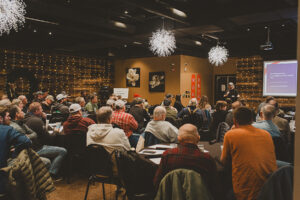Over 140 farmers and agricultural professionals gathered from around the region to talk about farming, soil testing, and local field research. Organized at the direction of local Farmer-Led Councils of northwestern Wisconsin, speakers highlighted some big takeaways on how farmers need to take another look when calculating their fertilizer plans.
The morning was kicked off by Lance Gunderson of Nebraska’s Regen Ag Lab. Gunderson is recognized nationally for his lab’s work, which provides soil testing that measures microbial activity (e.g., the Haney test). Microbial-inclusive soil testing is a hot topic in the industry right now. This is because conventional soil tests only account for a portion of plant-available nutrients. Gunderson noted that 90% of a plant’s nutrients pass through the soil’s microbiome before reaching the plant. Put mildly, the health of that microbiological network is kind of important. On average, Gunderson noted that their lab finds about 25 pounds more nitrogen per acre than conventional soil tests attribute.
Gunderson ended his presentation by noting that the farmer’s quest to maximize yield is akin to what he calls Gold Rush Syndrome. “You check how much you made at the end of the year only to find you broke even.” This makes you decide you need to go into more debt to buy more equipment and acres instead of trying to increase the profit on what you have to work with. Of course, he noted, yield is important. He also pushed back against the notion that farmers need to feed the world and push for yield. “You can’t feed 160 people per acre if you can’t feed the four people around your dinner table.”
Soil testing was not the only topic of the event. Local trials and research were presented as brief summaries of findings. After a lunch sponsored by Compeer Financial, attendees heard fast-paced lightning talks from local professionals who have done research trials in northwestern Wisconsin:
- Karl Geske from the Buffalo Trempealeau Farmer Network shared insights from planting green trials, gaining 8 inches more growth in cover crops in 9 days for weed suppression and crop management.
- Kurt Afdahl, a local crop consultant, discussed the importance of early bean planting. Last year he compared April 26th to May 12th planting dates. He saw an 8 bushel bump for the earlier planted beans. He also emphasized optimal emergence conditions for corn.
- Dane Christianson of Polk County Land and Water Resources Department summarized data from the Horse Creek Test Plot. He revealed no-till and rye cover crop trials’ superior water and soil retention, and comparable yield, despite slower emergence.
- Mark Serier, an agronomic consultant from Ag Strategies LLC, presented initial results on optimal nitrogen rates. These showcased minimal yield variation (10 bushels) despite a wide application range of nitrogen (110 to 230 pounds per acre).
- John Sippl from Dunn County NRCS shared yield results from Dunn County Demo Farm. He emphasized the economic effects of low-performing acres and potential impact of adding a small grain to the rotation.
- Finally, Joe Ailts, an agronomist from Ailts Agronomy, highlighted the importance of mycorrhizal fungi for crop performance, echoing the need to address underestimated nitrogen levels for cost savings in fields with Haney testing.


